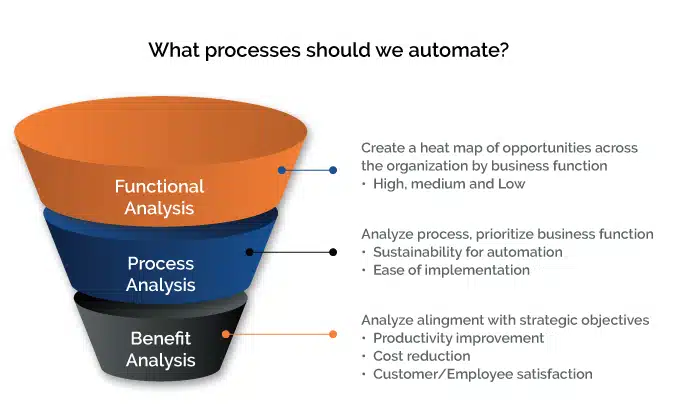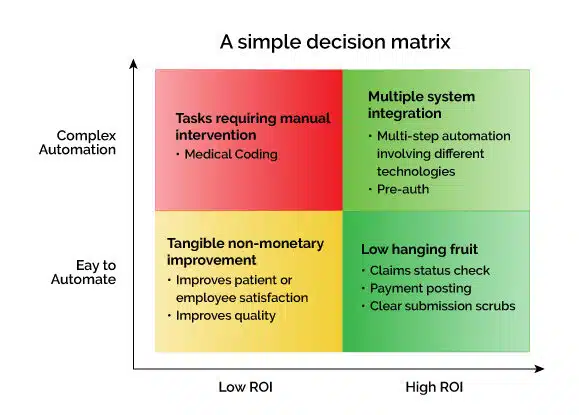Automation exists on a spectrum. Here’s how to identify processes to automate with minimal investment and substantial return (Part 2 of 2).
Automation is an effective way for healthcare organizations to solve revenue cycle personnel shortages (see Part 1) Healthcare organizations can choose from a wide spectrum of proven automation technologies. That’s the challenge, though. There’s a definite cost and impact continuum healthcare organizations must think about when selecting automation use cases and technology.
At one end of the spectrum, deploying automation technology can be done cost effectively and quickly for high returns with relatively simple robotic process automation (RPA). At the other end of the spectrum, AI is more powerful and can solve a host of complex problems. Its use, especially in hospital settings, has been primarily in the clinical sphere. No doubt, over time, AI/ML use cases that reliably handle revenue cycle challenges like coding and voicebots will become sustainably real, but that future is still some distance away. Healthcare organizations must carefully select what processes to automate to ensure the results meet their needs.
In general, the more advanced the technology, the more time and expense required to implement it. That’s not to take these options off the table. There’s an appropriate context for every automation technology. But less complicated and less expensive RPA solutions can immediately address staff shortages, clear backlogs and unclog revenue streams.
Identifying optimal areas for automation
The first step is to identify RCM processes that are candidates for automation. Many opportunities for automation exist across the RCM value chain. Often the people working on the tasks are in the best position to identify steps or entire processes that can be automated. Here are some of the markers that indicate a task or process is suitable for automation:
- Rote: The task requires very little, if any, intelligence, experience or insight to perform. Through an application’s existing interface, RPA bots mimic the steps of a human operator, do calculations and make decisions where all the variables are known. RCM staff are freed up to do more rewarding tasks that require their full expertise, a benefit that should improve job satisfaction and retention.
- Repetitive: This describes any simple process that has repetitive steps that take standard inputs and deliver a standard outcome, including claim status checks, benefit verification and eligibility checks. Software bots can do these tasks faster, never getting bored, never making errors, helping to speed a variety of processes that can help bring in revenues faster.
- Swivel chair: These are tasks that require data to be copied and pasted across multiple systems, such as moving account follow-up notes from an old system to a new one, or steps that cross multiple systems, such as accessing patient data on the EHR for use by a patient engagement system. Your IT department may not have the time to integrate these systems or write application programming interfaces (API) for them. Software bots can learn these tasks in a few weeks, then put their skills to work immediately.
- Rules-based: Software bots can follow simple, set rules for making if/then decisions; AI and ML can make more sophisticated decisions based on data models that contain more variables, yet have discernible patterns. The simpler the decision, the quicker the implementation.
- Manual workarounds: Disconnects between applications where a human must complete a step manually often point to a step or process that can be streamlined by a bot.
- Double data entry: Processes and reports that call for copying and pasting the same data among multiple systems and applications usually can be addressed with software bots.
Making the automation grade
Once you’ve identified tasks and processes with one or more of the “ripe for automation” markers, create a heat map. Grade the automation opportunities for their complexity and potential return. The higher the volume of work affected, the higher the potential return, especially if the process involves many opportunities for software bots to take over rote, repetitive, standardized steps (see Figures 1 and 2).
Processes that still require a significant degree of human involvement tend to be more complex. It likely will take longer to identify all the process steps and develop the optimal workflow for bots and human interaction. These processes may still deliver substantial returns from automation but the cost and time to implement them are generally higher. Whether the time and expense are acceptable depends on each provider. Those needing a fast turn and improvement on revenue flows likely should focus attention on clearing backlogs and reducing errors.


Making the decision
Be clear about what you hope to achieve with automation and realistic about the time and resources you have available. We recommend working through the following steps to guide decisions about which RCM automation projects to tackle.
- Choose low-hanging opportunities first. Build up your organizational automation experience before attempting more ambitious projects. We created an RPA solution to help a provider solve its claims backlog with a single large payer first. Now it’s expanding that initiative to other payers and also considering how to expand automation upstream and downstream the RCM value chain to further improve those processes.
- Choose opportunities that minimize IT involvement. Your organization’s IT professionals likely have additional priorities and may not be able to give much support to RCM automation efforts.
- Choose a vendor that understands healthcare revenue cycle solutions. Working with a skilled, experienced vendor helps minimize the time and input your organization’s RCM professionals must give to the Vendors with RPA and healthcare expertise can build flexible bot frameworks so bots can be extended to other applications with minimal programming.
- Prioritize opportunities that tangibly improve patient and employee experience. Improving the patient financial experience is a growing priority. Automating tedious, repetitive tasks reduces errors and frees your RCM staff to work on more complex issues that deliver more value to patients and your organization.
- Evaluate the return on investment. In our experience, most RPA automations deliver a return 2 to 3 times greater than the investment. Reconsider projects that have lower anticipated returns or that indicate a long time to ROI.
The choices about automation continue. Your organization’s IT infrastructure, development choices and ongoing software bot management likely will vary from those of other organizations. Be sure your vendor suits your specific situation.
The societal changes that have shrunk healthcare’s labor pool are here to stay. Healthcare providers that embrace automation across their RCM value chain will be well positioned to improve cash flow, enable RCM staff to work at the top of their abilities and offer patients the digital experiences they increasingly expect. Most importantly, these providers will have more of the financial resources they need to focus on their true expertise, delivering patient care and improving outcomes.
For additional information or questions on how Firstsource can help your organization leverage automation across the revenue cycle, please contact Angela Billet, SVP Strategic Provider Accounts or Vimal Nagarajan, VP Technology.










